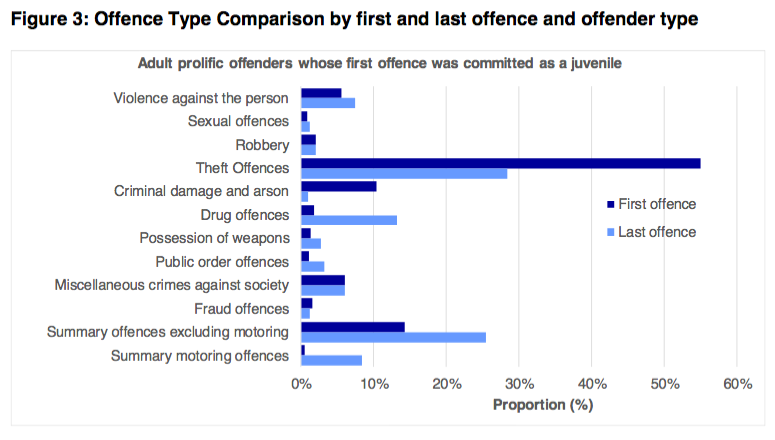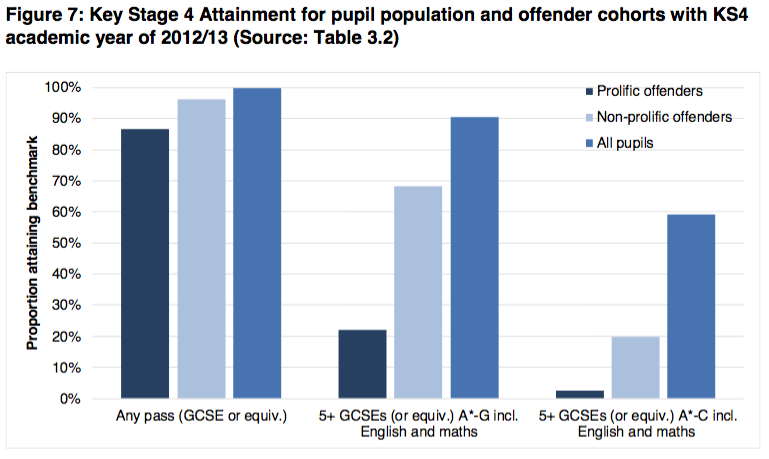MoJ analysis reveals trends in prolific youth offending
Joanne Parkes
Thursday, May 16, 2019
High rates of juvenile offending among prolific adult offenders, as well as links to poor educational attainment, poverty and school exclusions, are revealed by new Ministry of Justice data.

Almost 80 per cent of adult prolific offenders received their first caution or conviction as a juvenile, the Prolific Offenders Criminal Pathway: Prison Events & Offender Needs report finds.
Prolific offenders typically have lower levels of educational attainment at secondary school than non-prolific offenders, the analysis also shows.
The data also shows that higher proportions of prolific offenders than non-prolific offenders had special educational needs, as well as considerably higher rates of absence and exclusion.
A prolific offender is someone who has committed a disproportionately large number of offences relative to their age group - four or more offences for juveniles, eight or more for young adults and 16 or more for adults.
The report compares the rates of offending per offence type committed as a juvenile (aged 10 to 17) to those committed most recently as an adult.
Theft was the most common first offence and last offence.
For more than half (55 per cent) of persistent offenders, their first crime was theft, reducing to under 30 per cent at the last offence.
Rates of drug offences markedly increased from around two per cent to 13 per cent, while arson reduced from around 11 per cent to one per cent.
Summary motoring offences were uncommon at less than one per cent among juveniles who became prolific offenders, rising to around eight per cent when they became adults.

Graph: Ministry of Justice
At both Key Stage 2 (KS2, ending at age 11) and Key Stage 4 (KS4, ending at age 16), prolific and non-prolific offenders both have considerably lower levels of attainment than the wider pupil population.
The data shows that 22 per cent of prolific offenders achieved five or more GCSEs at grade A*-G, including English and maths, compared to around 68 per cent of non-prolific offenders.
The rates were around three per cent and 20 per cent respectively for the A*-C grade range.
In each of these categories the rates across all pupils were 90 per cent and 59 per cent respectively.

Graph: Ministry of Justice
Special educational needs (SEN)
Higher proportions of prolific offenders than non-prolific offenders had SEN.
This applied both in their KS4 year and across the previous five years, and for SEN with and without a statement.
For example, 44 per cent of prolific offenders had SEN without a statement in 2012/13, compared with 38 per cent of non-prolific offenders and 17 per cent of all pupils.
Free school meals
A similar pattern was observed for free school meal (FSM) eligibility - prolific offenders were more likely than non-prolific offenders to be eligible, both in their KS4 year and across the previous five years.
Some 43 per cent of prolific offenders were eligible for free school meals in 2012/13 compared to 32 per cent of non-prolific offenders, and 15 per cent of all pupils.
Absence and exclusions
In addition, two-thirds of prolific offenders were persistently absent in their KS4 year, and 92 per cent in at least one of the previous five years, compared with half and three-quarters of non-prolific offenders respectively.
The difference between these groups is even greater for exclusions, with 91 per cent of prolific offenders having ever been excluded for a fixed period, compared with two-thirds of non-prolific offenders.
Some 23 per cent of prolific offenders have been permanently excluded, compared with seven per cent of non-prolific offenders.
The report states that the "analysis does not imply causality as offending may have taken place before or after these characteristics were held".
Government reaction
Responding to the findings, Education Secretary Damian Hinds, said: "No young person should become a crime statistic.
"I have said before that preventing absence from school among vulnerable pupils is crucial, because school provides the best opportunities for them to make the most of their potential, and acts as a protection, away from the threat of gangs, crime or exploitation.
"This new analysis reinforces how pivotal education is for young people, especially those most at risk of being led down the wrong path in life."




